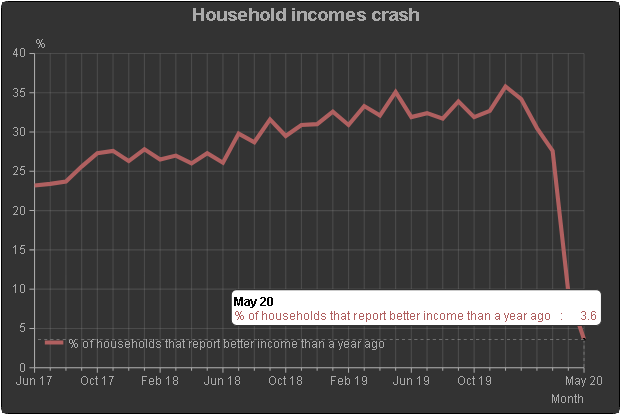
A very large proportion of households in India are facing income contraction. Severe stress on account of income was seen in households in April 2020. This worsened in May.
An improvement in aggregate employment during May has given no respite on the income front to households. The employment rate improved from 27.2 percent in April 2020 to 29.2 percent in May. This translated into an additional 21 million jobs. However, this did not help improve household incomes.
In April 2020, 49.3 percent of households had mentioned a contraction in their incomes compared to a year ago. This marked a sharp deterioration from the less-than-10 percent households that stated that their incomes were lower than a year ago till the lockdown impact hit household incomes.
In May 2020, matters got much worse in spite of the improvement in employment. Now, 68.3 percent of households said that their incomes were worse than they were a year ago. Evidently, the lockdown has impacted household incomes a lot more than employment.
A measly 3.6 percent of households said that their incomes were higher than a year ago. And, 28.1 percent said that their incomes were unchanged compared to a year ago.
A negativity has also set in among households regarding their own future incomes. 68.2 percent of households believe that their incomes a year ahead would be worse than their present incomes. This is extraordinarily pessimistic. Before the lockdown, less than 8 percent of the households believed that their household income would be lower a year into the future. But, this proportion increased to 49 percent in April and then to 68.2 percent in May 2020. Only 3.8 percent of the households believed that they would be better off a year later.
This pessimism seems to stem from a certain despondency about the economy at large. A massive 72.5 percent of the households believe that business conditions would deteriorate a year from now. Only 0.3 percent believe that business conditions would improve over the next year. These are record levels. Negativity on India’s economic prospects was, perhaps, never so high.
The mood switched immediately upon imposition of the lockdown from March 25. Pessimism shot up in the form of people fearing that the future would be worse a year ahead. The proportion of people who were pessimistic in this sense rose from 14 percent just the week before the lockdown, the week that ended on March 22, to 8 percent in the first week of the lockdown. Since then, this proportion of those with a gloomy outlook has risen steadily to average at 68 percent in May.
Hopes on the longer term ain’t much better. It is natural for people to believe that an economic downturn is only temporary. And, it is almost self-defeating to believe that there is no hope in the long run as well. But, data reveal such a self-defeating hopelessness setting in.
While 0.3 percent of the households believe that conditions would improve over the next year, only 1.7 percent believe that they would improve over the next five years. That is hardly any real improvement. This also reflects the nature of the negativity. Households do not seem to believe that this fall in incomes is a temporary or even a short-term setback. The lockdown seems to have cast a long dark shadow over the foreseeable future of households.
A substantial 43.8 percent believe that conditions would remain as bad as they are now even five years into the future. Worse still, 54.5 percent believe that conditions would get worse.
This negativity regarding the long-term prospects for business conditions got bad in April itself. But, it has gotten worse in May. This is somewhat worrying because there were signs of the lockdown being lifted. Perhaps, the serialisation of lockdown – from 1 to 2 to 3 and 4 and the uncertainty regarding a return to normal business has taken a toll on sentiments.
The index of consumer sentiments (base: 100 during September-December 2015) fell to 30.9 in May 2020. This implies a massive 32.4 percent fall during a month after a 53 percent fall in the previous month and a 7.6 percent fall before that in March 2020. The index has been falling month after month since January 2020.
The index was 108.2 in December 2019. It dropped to 30.9 in May 2020. The urban index was down to 23.5.
The sharp deterioration on the household incomes front in May 2020 even in the face of an improvement in employment during the month implies that the jobs that came back in May were of poor quality. Deep financial distress could have driven vulnerable households to accept jobs at lower wages.
The little growth in employment in May is, therefore, no cause for celebration. The sustained deep negativity of Indian households regarding their own future is unsettling. It is unsettling that the negativity regarding long term prospects worsened even as the lockdown was being lifted, albeit partially, in May 2020.










